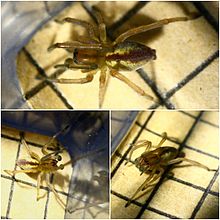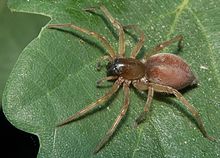Heather thorn finger
| Heather thorn finger | ||||||||||||
|---|---|---|---|---|---|---|---|---|---|---|---|---|

Heidedornfinger ( Cheiracanthium erraticum ), female |
||||||||||||
| Systematics | ||||||||||||
|
||||||||||||
| Scientific name | ||||||||||||
| Cheiracanthium erraticum | ||||||||||||
| ( Walckenaer , 1802) |
The Heide Dornfinger or the Heide-sac spider ( Cheiracanthium erraticum ) is a spider of the genus Dornfinger in the family of miturgidae (written Cheiracanthiidae, formerly Cheiracanthidae, some authors prefer the alternative name Eutichuridae). The species is widespread in the Palearctic and is also the most common member of the family in Central Europe .
features
The female of the heather thorn finger reaches a body length of eight to nine and the male one of five to 6.5 millimeters, of which the prosoma (front body) in the female is 2.1 to 3.9 millimeters and in the male 2.5 to 2.9 millimeters occupies.
The prosoma and the legs of the heather thorn finger are yellow-brown to greenish in color. The tips of the chelicerae (jaw claws) appear clearly darkened. In the male, the cymbia (components of the bulb or male sexual organs) are provided with a spur that barely protrudes over half of the tibia (leg braces) of the pedipalps (transformed extremities in the head area, on which the bulbs are located). The length of the tip of the cymbium is more than a third of the cymbium itself without its spur.
The opisthosoma (abdomen) of the species has a yellowish green basic color. A continuous, yellow-lined and dark red longitudinal stripe runs in the center. The epigyne (female sexual organ) located underneath in the female has two tortuous spermatheks (introductory organs).
Similar species
There are also other similar species of the genera in Central Europe, which can usually only be reliably distinguished from one another by genital morphological features. Many of these species, however, are more strongly tied to special biotopes and are therefore significantly less common than the heather thorn finger. An example of such a distinct species is Penny's thorn finger ( Cheiracanthium pennyi ).
In addition, the heather thorn finger, like all thorn finger spiders , can be confused with species of the sack spider family (Clubionidae), to which they were previously included. Especially the actual sack spiders ( Clubiona ) resemble the heather thorn finger. However, with all thorn finger spiders, including the heather thorn finger, the first pair of legs is significantly longer than the next, while the second pair of legs is longer in the actual sack spiders. In addition, unlike the thorn-finger spiders, the rear of the two rows of eyes is longer than the front in the real sack spiders.
Occurrence

The heather thorn finger has a large distribution area that includes Europe , Turkey , the Caucasus , Russia from the European to the Far Eastern part, Iran , Central Asia , China , Korea and Japan . The species has been detected there at heights of up to 700 meters above sea level.
The preferred habitat of the heather thorn finger are dry or slightly damp and open areas that are covered with low vegetation (such as herbs, low shrubbery or grass). Examples of such habitats are sunny forest edges and wet meadows and in northern Germany also lightly grassed heather areas . The spider is in the middle of the vegetation.
Threat and protection
The heather thorn finger is common in many parts of Central Europe and is also the most common type of family in this area. In the Red List of Threatened Species of Animals, Plants and Fungi in Germany , the species is classified as "not endangered " and does not enjoy any protection status.
The global population of the Heidedornfingers is not evaluated by the IUCN .
Way of life
The Heide Dornfinger like all miturgidae primarily nocturnal and hunts free running without safety net as lurking predators of other arthropods in the appropriate size, while on the day in a living tissue is staying that the bag-shaped the sac spider is similar (Clubionidae). For this web, blades of grass or individual leaves are often spun together.
Phenology
The activity time of the heather thorn finger is between March and October in females. In the male, the period between March and July is much shorter.
Reproduction
The mating season of the heather thorn finger takes place between March and June. From July onwards, a mated female begins to create an egg cocoon in its web of living space. The young remain with the female for some time and, like the egg cocoon, are vehemently defended against possible predators (predators) by the female . If the dwelling is opened, the female assumes the threatening gesture typical of thorn-finger spiders , in which the chelicerae are spread apart. In contrast to larger species of the family, such as the wet nurse's thorn finger ( Cheiracanthium punctorium ), the heather thorn finger is not able to penetrate the human skin.
After some time, the young spiders leave their mother's web of living space and become independent, so that even late in the year young spiders can be found that do not yet show the coloring of the adult animals, but already have the colored central band on the opisthosoma. The young behave like adult spiders and also create webs of living space. They reach sexual maturity in the following year.
Systematics
When it was first described in 1802 by Charles Athanase Walckenaer, the heather thorn finger was classified as all spiders in the genus Aranea and given the name A. erratica . The name Cheiracanthium erraticum , which is common today , was introduced by Nicolas Westring in 1861 and has been used as a name for the species since 1925.
Due to the multiple renaming and rearrangements, the Heidedornfinger has a large number of synonyms today. These are:
- Clubiona erratica Walckenaer , 1805
- Clubiona nutrix Hahn , 1831
- Clubiona dumetorum Hahn , 1833
- Bolyphantes equestris C. L. Koch , 1837
- Cheiracanthium carnifex C. L. Koch , 1839
- Anyphaena erratica Simon , 1864
- Cheiracanthium erroneum O. Pickard-Cambridge , 1873
- Cheiracanthium orientale Kulczyński , 1885
gallery
Excerpt from Monographia Aranearum = monograph of the spiders by Carl Wilhelm Hahn (1820)
Individual evidence
- ↑ a b c d e f g h i j k l Heiko Bellmann: The cosmos spider leader. Over 400 species in Europe. Kosmos Naturführer, Kosmos (Franckh-Kosmos), 2nd edition, 2016, p. 230, ISBN 978-3-440-14895-2 .
- ↑ a b c d e f g h Cheiracanthium erraticum (Walckenaer, 1802) from araneae Spiders of Europe, by Wolfgang Nentwig, Theo Blick, Robert Bosmans, Daniel Gloor, Ambros Hänggi & Christian Kropf, accessed on April 18, 2020.
- ↑ Cheiracanthium erraticum (Walckenaer, 1802) at the Wiki der Arachnologische Gesellschaft e. V., accessed on April 18, 2020.
- ↑ a b c Cheiracanthium erraticum (Walckenaer, 1802) in the WSC World Spider Catalog , accessed April 18, 2020.
- ↑ a b c d e f Cheiracanthium erraticum (Walckenaer, 1802) at the British Arachnological Society, accessed April 18, 2020.
- ↑ Cheiracanthium erraticum (Walckenaer, 1802) at the Red List Center, accessed on April 18, 2020.
- ↑ Cheiracanthium erraticum (Walckenaer, 1802) at Global Biodiversity Information Facility , accessed on April 18, 2020.
literature
- Heiko Bellmann: The cosmos spider guide. Over 400 species in Europe. Kosmos Naturführer, Kosmos (Franckh-Kosmos), 2nd edition, 2016, ISBN 978-3-440-14895-2 .
Web links
- Heidedornfinger in the World Spider Catalog
- Cheiracanthium erraticum (Walckenaer, 1802) in Fauna Europaea
- Cheiracanthium erraticum (Walckenaer, 1802) at the Global Biodiversity Information Facility
- Cheiracanthium erraticum (Walckenaer, 1802) at the Red List Center
- Cheiracanthium erraticum (Walckenaer, 1802) in araneae Spiders of Europe, by Wolfgang Nentwig, Theo Blick, Robert Bosmans, Daniel Gloor, Ambros Hänggi & Christian Kropf
- Cheiracanthium erraticum (Walckenaer, 1802) at the Wiki of the Arachnologische Gesellschaft e. V.
- Cheiracanthium erraticum (Walckenaer, 1802) from the British Arachnological Society





